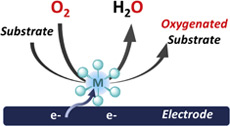Publication
887
Current Opinion in Electrochemistry 15, 118-124, 2019
DOI:10.1016/j.coelec.2019.05.002
|
|
|
|
|
|

|
Bioinspired molecular catalysts for homogenous electrochemical activation of dioxygen
|
|
|
|
Elodie Anxolabéhère-Mallart and Frédéric Banse
Laboratoire d’Electrochimie Moléculaire, UMR CNRS 7591, Université Paris Diderot, Sorbonne Paris Cité, 15 rue Jean-Antoine de Baïf, F-75205 Paris Cedex 13, France
Institut de Chimie Moléculaire et des Matériaux d'Orsay, Université Paris Sud, Université Paris-Saclay, CNRS, F-91400 Orsay, France
O2, which is abundant and environmentally benign, is the ideal green oxidant for oxidation reactions, which are key transformations in the chemical industry. Still, O2 needs to be activated, and this can be achieved through the so-called reductive activation of the O2 paradigm. Taking inspiration from metalloenzymes, where a non-noble redox active metal (iron, copper) controls the partial reduction of O2 via electron and proton transfers, metal-based synthetic systems can be developed to reproduce oxygenase activity. In the present article, we focus on fundamental aspects that serve as support for the development of 2-electron activation of O2 and generation of highly oxidizing metal-oxo species, thus paving the road for the development of electrocatalytic systems for organic substrate oxygenation. Scarce examples known in the literature capable of such reactivity and possible future developments are described. |

